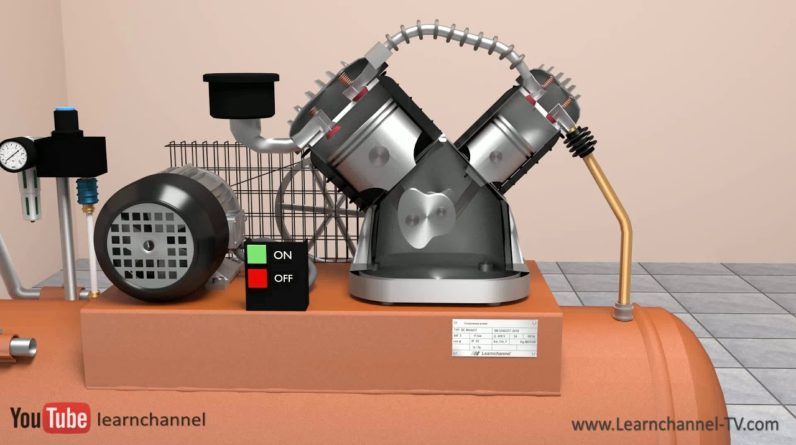
This air compressor consists of an electric motor that compresses air into a storage tank. The compressed air can be released at chosen pressure when required. How works an air compressor? What are the criteria for selecting a proper air compressor? Well there exists a variety of different compressor types. Let's continue with an overview. Normally the compressors used in the field of automation and workshops are the so called positive-displacement compressors. Here pressure is excited when air is drawn in a chamber and the volume of this chamber is reduced. In this video we want to confine ourselves to this type of compressors. Let's have a closer look at the reciprocating compressor. As the crankshaft turns, a piston reciprocates within the cylindrical housing. The inlet valve also called suction valve allows atmospheric air to enter the cylinder. This is done during a suction stroke of a cylinder. The outlet or discharge valve opens at high pressure during the compression strike.
Air heats up when it is compressed. This is a problem of each compressor. The result is not only a less efficient compression cycle, but also to a real danger of explosion if any inflammatory substances, such as oil or lubricant get contact with the overheated air and piston. Therefore the compression of a single-stage compressor is limited to an output pressure of about 10 bars or 145 psi. To achieve higher pressures you would use a multi-step compressor. Here a two-stage compressors is shown. The large piston builds the first stage. The air leaving the first stage can now be cooled before it enters into the second stage. With a two-stage compressor you achieve pressures over 20 bars or 290 psi. Multistage compressors with high power also can use water cooling to avoid overheating. Based on its working principle, the reciprocating compressor delivers only pulsed compressed air. Therefore this type of compressor is used in conjunction with a tank. However, the use of a tank offers the advantage that the compressor can be operated with a two point controller, resulting in less energy consumption and wear. The diaphragm compressor belongs to the family of the piston compressors. Here the suction chamber is sealed from the piston by a diaphragm.
As an advantage the compressed air in the compression chamber does not come in contact with the lubricated piston and thus can be kept free of oil. The weak point of a diaphragm compressor in general is its membrane itself since the elasticity is limited. You would use the diaphragm compressor for example in the food industry or to fill divers bottles. A totally different working principle has the so called rotary compressor, also named as vane compressor. The typical rotary compressor has a cylindrical housing. Adjustable rotary vanes with its center point on an offset drive shaft have contact with the housing.

So when the shaft rotates these vanes create chamber of variable sizes. Air is sucked into the largest chamber, being compressed and leaves the compressor at the smallest chamber. Advantage here is in the pulsation free flow in contrast to piston compressors. Therefore an air tank may be optional. In addition these compressors are quiet and relatively insensitive to dirt. Typical application are for example: Wastewater treatment, fish breeding aeration, dust collection, vacuum packing and so on.
Watch also our next videos.




